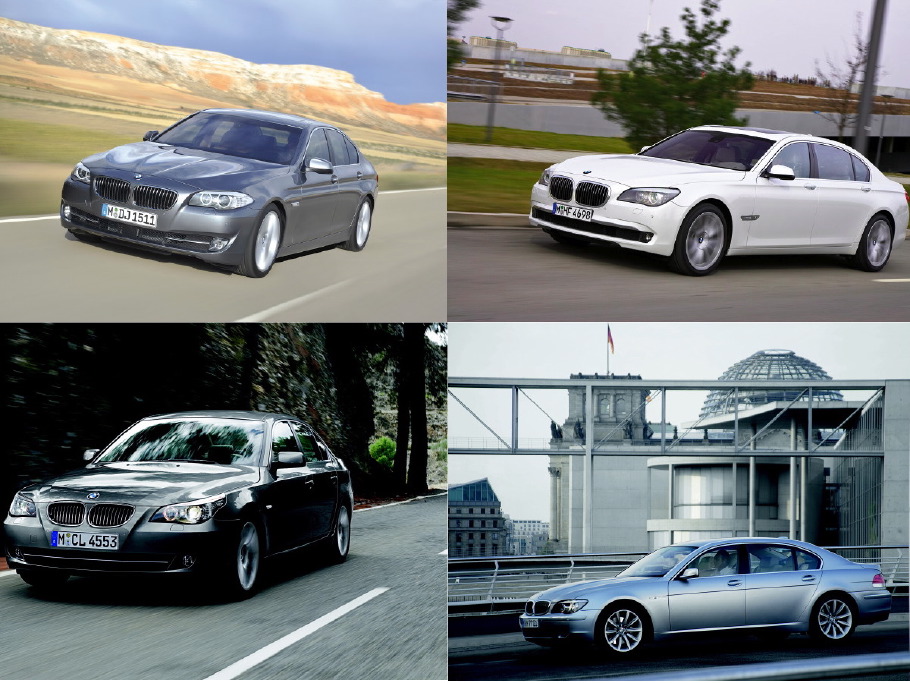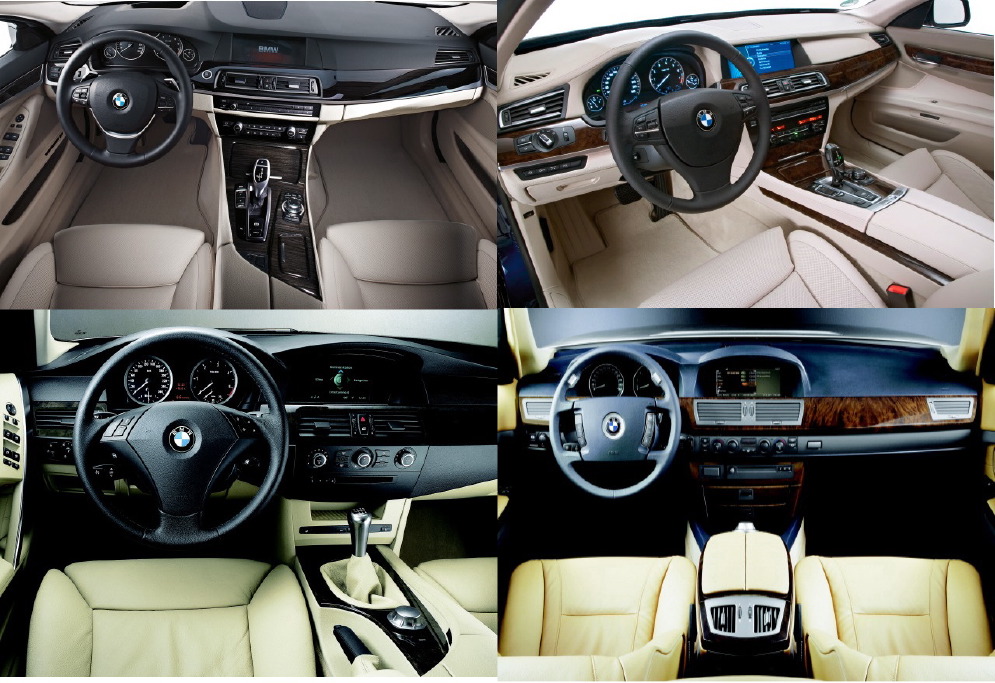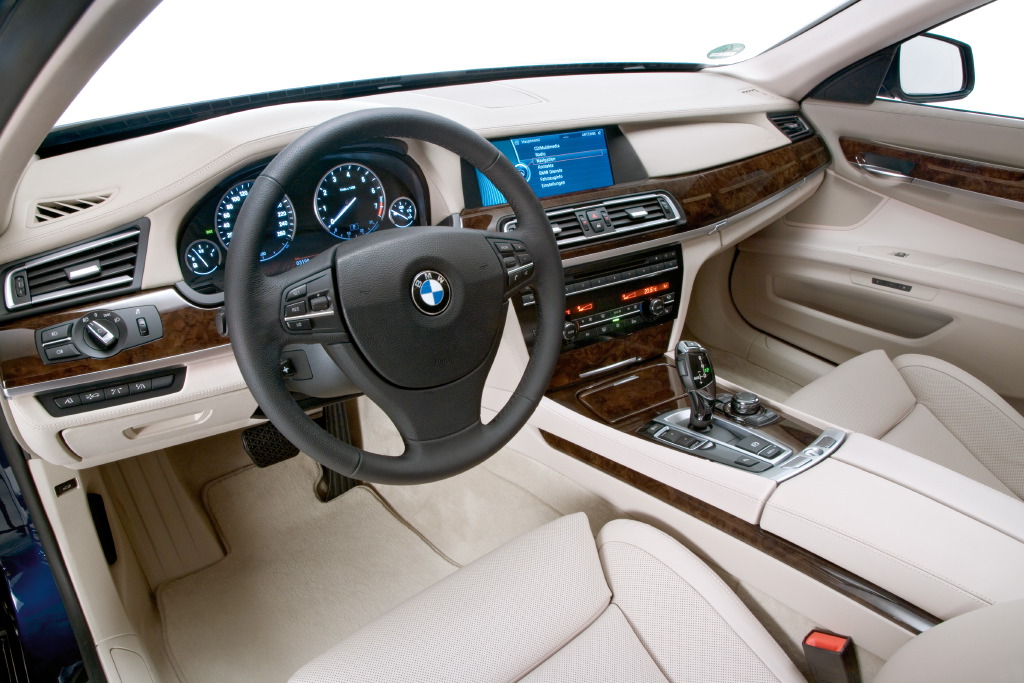While this editorial has been in the works since late last year, I have refrained from publishing it until now- to better coincide with the official public unveiling of the the 2011 F10 BMW 5 Series.
BMW since the 1970′s has had separate classes of sedans based mainly on size and the level of luxury. This was even true through the late 80′s and 90′s when BMW was accused of producing “the same sausage at different lengths”. The 3 Series has always been the smaller sportier car with less luxury and available options while the flagship sedan was the posh 7 Series. The 7 exuded class and luxury. It was loaded with latest exclusive technologies and ultra premium materials while providing its clientele with copious quantities of space both in the passenger compartment and luggage area. The 5 Series has always been somewhere in the middle in terms of size, luxury and available technology.
Looking at the current 3 series (E90: 2005- current), the current 5 (E60: 2003- until this June), and the last generation 7 series (E65: 2002-2009) it is hard for most to discern the shared design language let alone shared components. Chris Bangle led the revolution to change the look of BMWs, “We were making sausages at different lengths and management at that time and especially Chairman Eberhard von Kuenheim and technical director Wolfgang Reitzle felt we needed to break away and chart a new course for the company and the brand,” Bangle said in David Kiley’s book Driven: Inside BMW, the Most Admired Car Company in the World. Under his leadership (he did not pen the designs) each model had its own style and enough exclusive bits and pieces to make each standout as an individual. Engines, transmissions and other mechanicals were shared throughout the lineup but for the most part things went their separate ways, especially once you openned the doors and gazed at the interior.
From the climate control, the iDrive controller and the gauge cluster, to the gear selector and the steering wheel; each car was unique. Technology was often different in each car and individual items made each special; the 7 with its love it or hate it compass direction controlled iDrive, the 5 Series with an optional Heads Up Display, and the 3 with a key fob rather than a true key are just a few.
This previous generation of models were all designed and mainly built during a period when BMW was pushing sales levels to the max as a way to reach economies of scale. Economies of scale is buying/making things in bulk to obtain a cheaper per unit price. Instead of buying 1 pound of chicken breast at Stop and Shop some opt to buy 10 at Sam’s Club so each pound is cheaper, cars are not that much different. The biggest issue for BMW in reaching scale, as an independent manufacturer, was that it did not have a less prestigious in house brand (selling sedans) to split costs with so they had to produce/sell more of their own products to reach volume. Many to this day believe this is why BMW artificially inflated lease residuals up until recently- to get more product out the door (that is for a different discussion) by offering a cheaper per month payment and therefore lessen the cost per unit to build. Over the course of time, this plan was proven to be less successful than BMW had hope for because the more cars that are in the market lessens the value of a used car (simple law of supply vs. demand) and the inflated residuals subsequently costed them an arm and a leg.
For BMW to remain viable and competitive something needed to change in order to reach economies of scale. There were varying proposals, such as buying another lesser competitor (in this case Volvo) and sharing more with MINI. In the end, what changed was how BMW would design future vehicles and the formation of buying agreements/co-development with other external marquees; a different means to the same end goal of producing great driving vehicles while remaining financially strong.
With the new 5 Series we see a distinct departure from BMWs more recent model individuality. The new 5 can be described from an exterior design as the front of the 7 series and back of the 3 with some more aggression and substance thrown in the hood and along the sides. The 5 is in the middle of these two so it is sort of apropos that that major difference is in the middle.
Some report that almost 80% of the 5 is shared with its high line sibling the 7. From to outside you would not know that, but once inside the similarities are a bit overwhelming. Much of the controls and electronics are identical. The black panel LCDs, the gauge cluster, the steering wheel, the shifter- the list goes on and on.
What once was sacred to the 7 has now been passed on to the mid-range 5 series. From a size perspective the newest 5 is as large as the 7 was two generations ago, granted technology has come a long way and there have been great improvements in build quality but does the 5 encroach into the 7 Series too much?
That is a question that I posed late last year to the 6 and 7 Series product manager from BMWNA, Alanna Bahri. As Ms. Bahri kindly explained to me, “there are a lot of shared items and technology between the cars but there are notable differences. The 7 Series will come with more standard features in base trim and offer higher quality materials throughout the cabin to improve the overall cabin ambience. Another difference between the two model lines will be the 7′s ability to be customized to the owner’s liking even further through BMW Individual.”
Something even more in the 7′s favor as being a step above is that there are exclusive versions of it such as the 760Li and Alpina B7. The 7 has a longer wheel base and greater rear leg room than the 5 which provides a more comfortable ride for passengers while they are being pampered in luxury.
To a man who unfortunately notices the smallest difference in things (a gift and a curse), there are significant differences in the fine details between these models. All of the surfaces in the 7 that look to be a fine leather are just that; the door panels, seat sides, backs and the arm rest. This can not be said for the 5. The 5 (and 5 GT) follow the likes of Audi and other brands in touting that a car has “leather seating surfaces”. Translation- whatever your body touches on the seat when seated is leather and everything else is a high grade leatherette, aka- plastic. Audi somehow has been winning critics over with this approach for years and BMW is now doing the same. Most will not even notice the difference, but I sure did and the fact the 5′s base leather is not the same grade as the 7 really stands out.
The trim and “aluminum” do not have the same visual depth as in the 7 nor do the door pulls and compartments have the same weight to them. The air vents are superior in the 7, offering up a diffuser mode so air does not blow on you like a gust of wind; to me the carpets even feel different (could be over analysis but I doubt it) as do the dash and tops of the door panels. Everything seems to be one material grade down once you enter the 5 when coming from the 7. This is not to say the 5 is not well built or use great materials, it is just that the 7 is a tick above and this is just as it should be.
Discerning buyers will get what they pay for in each model line. There are similarities between these two but there are also differences that are significant enough to separate each one from the other. While to some this new 5 may be encroaching on the 7 a bit more than in the past in my view it really is not.
Many BMW driver’s are also fans of fine watches so let me use this analogy- the 5 is a very nice and well respected Breitling or Omega while the 7 is the like the ultra exclusive offerings from Panerai or Vacheron Constantin. Either way you can not go wrong!























